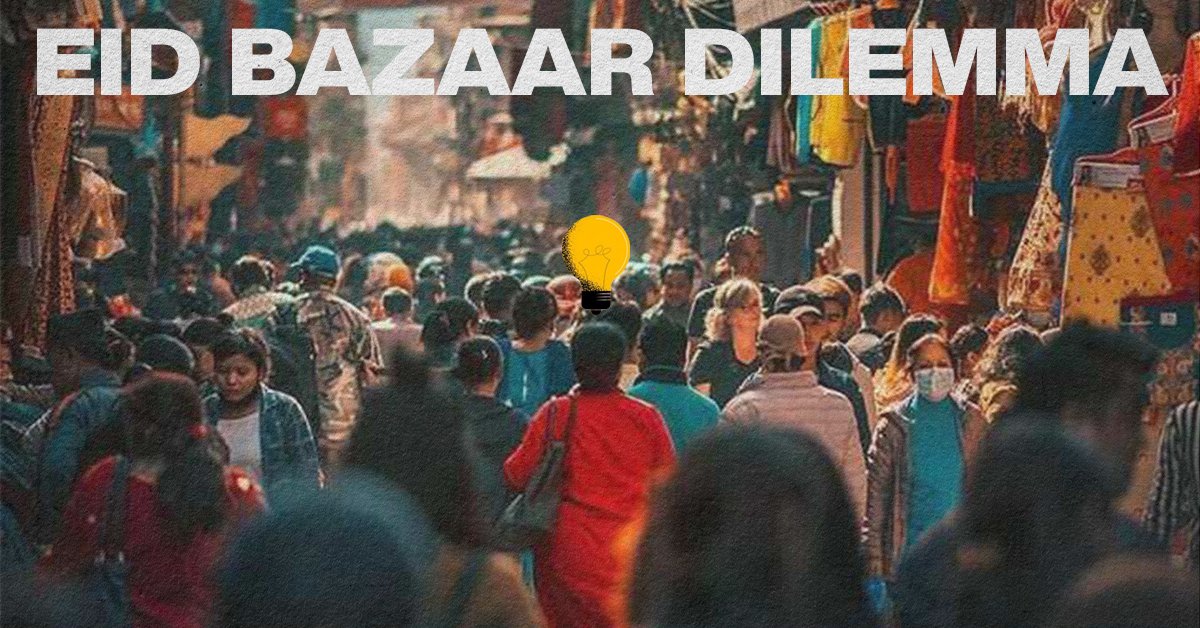The Psychology Behind Eid Discounts – Why We Can’t Resist a Good Deal
With only a few days left before Eid, you step into a mall, determined to buy yourself only a Panjabi or Kameez. But as you enter the battlefield of discounts, glowing neon signs captivate your eyes: ‘Limited Time Offer – Flat 50% Off!’. Your heart races. If you miss out right now, would you regret it later?
You weave through the crowd, seeking calm but finding chaos. Vendors shout, mothers haggle, and teens debate deals. Exasperated, you bargain for loafers, your voice lost in festive music, cash register beeps, and children’s screams. The air hums with urgency—this isn’t just shopping; it’s tradition.
We’ve all been there—falling for a deal we didn’t plan on, spending more than we intended. But why does this happen? Today, we’re breaking down the psychology behind these tactics and how to avoid them to get the best value for your money this Eid.
THE SILENT ADDICTION: DOPAMINE RUSH
The Science Behind Instant Gratification
Have you ever felt that sudden thrill when you find a great deal? That rush of satisfaction after purchasing something new? That’s your brain releasing dopamine, the feel-good neurotransmitter responsible for motivation and pleasure. Yes, it’s the same dopamine released when you’re out with friends, binge-eating, or watching your favorite movie. Acting like the brain’s reward system, it allows us humans to evolve into independent beings with our own choices and preferences. However, companies today have successfully hijacked this part of our brain to make shopping feel just as rewarding.
Research from Stanford University (Knutson et al., 2007) discovered that making a big purchase, grabbing a sweet deal, and even swiping cards activate the same region of the brain associated with reward and pleasure.
This surge of dopamine, however, is quite temporary, leading to instant gratification instead of long-term happiness or gain. Thus, once this minute relish wears off, customers often suffer through buyer’s remorse and trap themselves in an ever-running loop of washing their wallet down the drain.
However, that’s not all—there are some very specific tricks businesses use to ensure you are hooked like an addict, filling their riches while emptying yours.
BUSINESS TACTICS THAT TRICK OUR BRAIN
The Scarcity Effect – ‘Limited Time Offer’
Ever felt the sudden urge to buy something solely because it’s ‘limited edition’ or low on stock? That’s the scarcity effect, a well-recognized and documented cognitive bias where we often assign more value to things that seem rare or exclusive.
A study published in the Journal of Consumer Research found that perceived scarcity increases desirability because our brain equates it with high demand and limited supply (Cialdini, 2001). When we see phrases like “Only 2 left in stock” or “Sale ends in 2 hours”, our amygdala, the brain’s fear centre, kicks in—triggering FOMO (fear of missing out) and making us more likely to purchase impulsively.
How to Avoid
- Hold your horses, pause and assess: Is the item a limited edition or just a marketing bluff?
- Compare: Compare pricing and quality with similar products that are readily available to judge whether the exclusive tag is worth any hype.
The Decoy Effect: The Trick Behind ‘Buy One, Get One’
Buy one get one (BOGO) is an offer almost everybody is familiar with, but have you ever wondered why it always felt so lucrative? Ever noticed how companies often place an inferior product with a worse deal next to a better product at a much better deal? That’s the decoy effect—it influences our brain by introducing a third, much less appealing option which makes the other deal a no-brainer.
Dan Ariely, a professor of psychology and behavioral economics, demonstrated this in his book ‘Predictably Irrational’ (2008). He showed how when presented with three pricing options, consumers tend to choose the “best value” even if they wouldn’t have picked it otherwise.
For example, a shop puts up:
- One T-shirt for 1000৳
- Two T-shirts for 2000৳
- Buy one get one for 1400৳
Most people would almost instantly rush to the third option even if they don’t need a second T-shirt just because it seems like a better deal than the others.
How to Avoid
- Ask yourself: Would I buy this if it didn’t come with the offer?
- Check unit prices separately – oftentimes individual items cost less than buying through an offer.
Anchoring – The Illusion of a Large Discount
Why do we fall for ‘Was 5000৳ now 2500৳’?
Ever seen a huge sale that slashed down prices of items previously ridiculously overpriced? Well, they’re still ridiculously overpriced, but it feels like a steal due to another cognitive bias called Anchoring. This occurs because our brain is fixated on the first number and will compare everything else with that first number.
Kahneman & Tversky (1974), in their Nobel Prize-winning research, showed how our brain unconsciously uses the first number as a “mental anchor.” This means when you see “Original Price: 5000৳ → Now: 2500৳”, your brain sees it as a 50% savings, even if the actual worth was never 5000৳ in the first place!
How to Avoid
- Check the price across multiple stores
- Check the product’s actual market value instead of trusting the original or before pricing
The Sunk Cost Fallacy – “I’ve Already Spent So Much, Might as Well Get Some More”
It happens to the best of us—we set a budget and bring some extra cash just in case, fully intending not to spend it, yet somehow, it always disappears. Overspending beyond what our cards allow us to. Can’t stop now, right? That’s the Sunk Cost Fallacy which tells our brain there is no point in stopping now since you’ve already spent so much and justifies overspending even further.
A 2018 study in the Journal of Consumer Research found that shoppers who had already spent more felt a stronger urge to keep buying rather than walking away (Arkes & Blumer, 1985). Essentially, the more you spend, the more you feel like you need to make it “worth it”.
How to Avoid
- Set a strict budget limit
- Constant self-reminders: Past spending doesn’t justify future spending.
EMOTIONAL SPENDING: ‘IT’S EID AFTER ALL!’
Why We Associate Shopping with Happiness
Eid shopping isn’t just about clothes—it’s about tradition, celebration, and family. Marketers know this exceptionally well and exploit emotions to make us spend more.
A study by Harvard Business School found that emotions play a bigger role in spending than logic (Shiv & Fedorikhin, 1999). Seeing families shopping together, hearing festive music, and feeling the Eid excitement activates dopamine, our brain’s reward chemical, making shopping feel more satisfying.
How to Avoid
- Make a list and stick to it.
- Ask: Am I buying this because I need it or because it “feels” good?
FINAL THOUGHTS – OUTSMART THE SALES THIS EID
The Eid shopping rush is a mix of culture, excitement, and psychological traps that retailers use to make sure you spend more than you planned. By understanding these scientific tricks, you can shop smarter and make sure you get the best deals without falling into marketing traps.
So next time you’re out shopping and see a “Limited Time Offer!”, take a deep breath, think twice, and remember—you’re in control.
HAPPY EID, AND HAPPY SMART SHOPPING!
Written by: Rafid Bin Nashir
Edited by: Samiha Parvin





